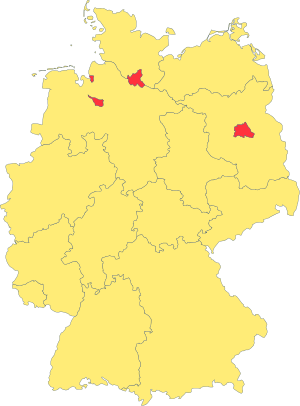Land (Germany)
| German Federal States Deutsche Bundesländer (German) |
|
|---|---|
|
Also known as: Länder (German) |
|
| Category | Federated state |
| Location | Federal Republic of Germany |
| Number | 16 |
| Populations | 671,489 (Bremen) – 17,865,516 (North Rhine-Westphalia) |
| Areas | 419.4 km2 (161.92 sq mi) (Bremen) – 70,549.4 km2 (27,239.29 sq mi) (Bavaria) |
| Government | State government |
| Subdivisions | Borough, District, Amt, Governmental district |
Germany is a federal republic consisting of sixteen federal states (German: Land, plural Länder; informally also Bundesland, plural Bundesländer). Since today's Germany was formed from an earlier collection of several states, it has a federal constitution, and the constituent states retain a measure of sovereignty. With an emphasis on geographical conditions, Berlin and Hamburg are frequently called Stadtstaaten (city-states), as is the Free Hanseatic City of Bremen, which in fact includes the cities of Bremen and Bremerhaven. The remaining 13 states are called Flächenländer (literally: area states).
The creation of the Federal Republic of Germany in 1949 was through the unification of the western states (which were previously under American, British, and French administration) created in the aftermath of World War II. Initially, in 1949, the states of the Federal Republic were Baden, Bavaria (in German: Bayern), Bremen, Hamburg, Hesse (Hessen), Lower Saxony (Niedersachsen), North Rhine-Westphalia (Nordrhein-Westfalen), Rhineland-Palatinate (Rheinland-Pfalz), Schleswig-Holstein, Württemberg-Baden (until 1952), Württemberg-Hohenzollern (until 1952) and the Free State of Oldenburg (until 1946). West Berlin, while officially not part of the Federal Republic, was largely integrated and considered as a de facto state.
...
Wikipedia

